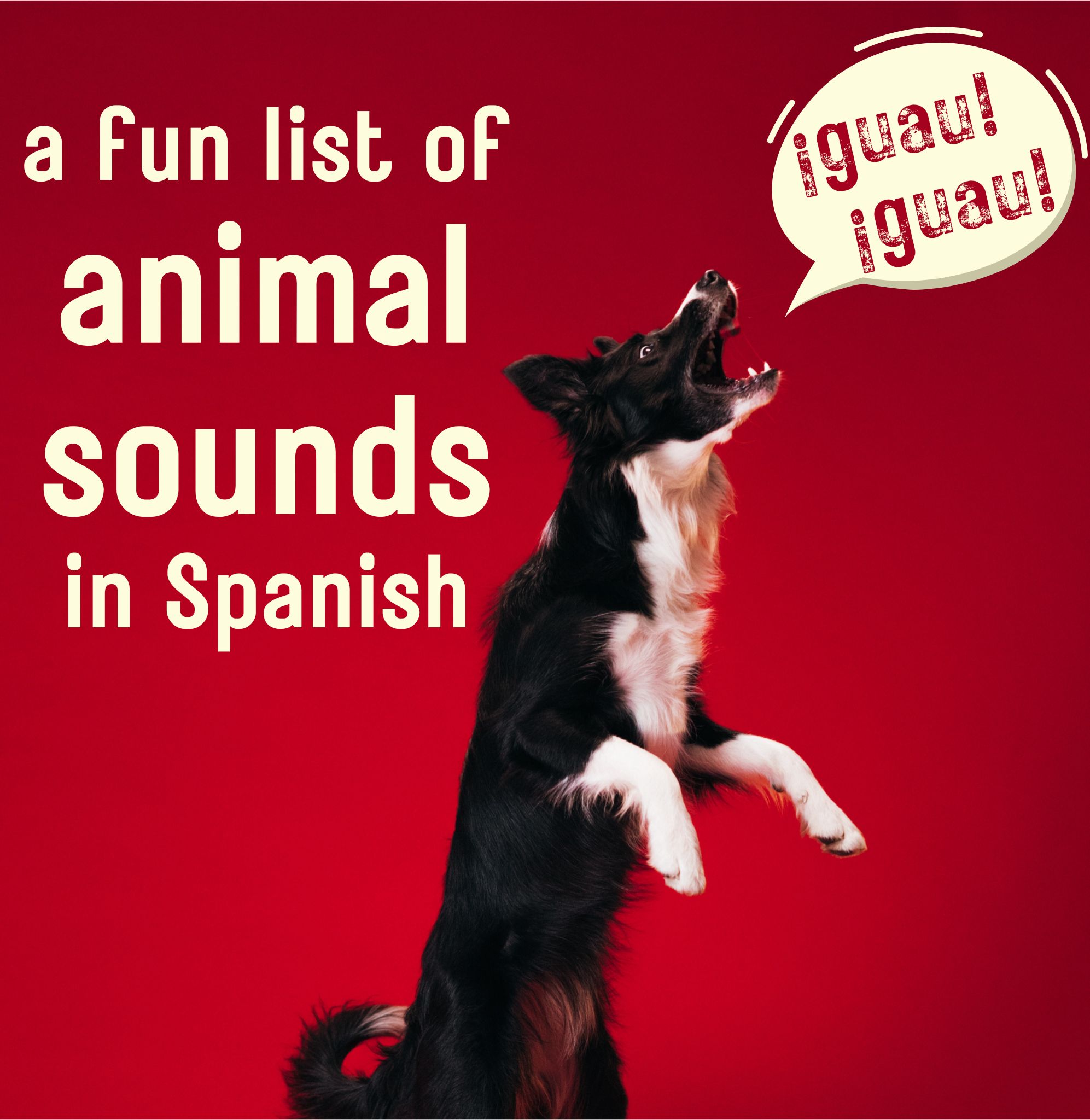Animal sounds in Spanish: A fun list of Spanish onomatopoeias

Get our free email course, Shortcut to Conversational.
Have conversations faster, understand people when they speak fast, and other tested tips to learn faster.
More infoIn English, dogs bark and say “woof,” but what sound does a dog make in Spanish? Onomatopoeias, or words that imitate sounds, add flavor and vividness to our expressions, and in Spanish animals have their own unique onomatopoeic representations.
In this article, we will delve into the fun world of animal sounds in Spanish and explore the onomatopoeias and verbs used to describe them. The Spanish world is pretty vast, so we’ll cover the ones that are used most widely.
Let’s dive into animal sounds in Spanish!
El perro (dog) – Guau, guau
When it comes to man’s best friend, the Spanish language captures the essence of a dog’s bark with the word guau. Whether it’s a small Chihuahua or a mighty Doberman, the sound guau remains a universal representation of a dog’s vocalization in the Spanish-speaking world.
In Spanish, ladrar is the verb equivalent meaning to bark, and el ladrido is the noun for a bark or barking. And what are some of the other dog sounds in Spanish? Here’s a list of other verbs to name their different sounds:
- Gruñir – To growl
- Gañir – To yelp
- Aullar – To howl
- Llorar – To cry
El lobo (wolf) – Auuu
In the heart of the wild, the wolf howls with a distinct sound that echoes through the night. So what does a wolf say In Spanish? The onomatopoeia for the sound is transcribed as auuu, with a long “oo” sound. The verb for to howl in Spanish is aullar, while the noun is el aullido.
El gato (cat) – Miau
Cats are known for their curiosity and their graceful nature, and their lovely meows are all over the internet. The identical onomatopoeia for this heartwarming meow in Spanish is miau. Additionally, the verb to describe the sound is maullar, while the noun is el maullido. When cats are angry or afraid, however, they hiss, which is bufar in Spanish.
El caballo (horse) – Hiii, hiii
The Spanish onomatopoeia for a horse’s neigh is hiii, hiii. The verb that describes the sound is relinchar, while the noun is el relincho.
El burro (donkey) – Hiaaa, hiaaa
Known for their resilience and patient demeanor, donkeys have their own unique voice. Whereas you say hee-haw in English, we imitate a donkey sound in Spanish with hiaaa, hiaaa. The verb used to describe braying is rebuznar, and the noun of a bray is el rebuzno.
La vaca (cow) – Mu
This Spanish animal sound is essentially identical to the English one, except that the we write moo in Spanish according to our phonetic rules: mu. The verb used for this animal sound in Spanish is mugir, while the noun is el mugido.
El cerdo (pig) – Oinc, oinc
To represent the grunting sound of a pig similarly to the English oink, oink, in Spanish we use the onomatopoeia oinc, oinc. The sound is called el gruñido, and the verb is gruñir.
La oveja (sheep) – Beee
The sound of a sheep in Spanish is often depicted as beee. This onomatopoeia imitates the bleating sound made by sheep, with an extended “e” sound. In Spanish, a sheep’s vocalization is called el balido, and the verb is balar.
El mono (monkey) – I, i, i
The onomatopoeia i, i, i is used in Spanish to imitate the sounds made by monkeys. This simple representation mimics their high-pitched chattering and vocalizations. In Spanish, the sound made by monkeys is el chillido, and the action is called chillar.
La serpiente (snake) – Sss
When it comes to snakes, the hissing sound they make is called siseo, and the verb is sisear. The Spanish onomatopoeia of this animal sound is simply sss.
El pájaro (bird) – Pío, pío
Birds are a diverse group of animals, and their sounds vary widely. However, the chirping sound commonly associated with birds is represented in Spanish as pío, pío, especially for baby chickens. The verb for this sound is piar, gorjear, or trinar and the sound itself is called el piar, el gorjeo or el trino.
El gallo (rooster) – Quiquiriquí / Kikirikí
This is perhaps one of the most different onomatopoeias from its English counterpart. The classic cock-a-doodle-doo in Spanish becomes quiquiriquí. The verb is cacarear and the noun is el cacareo.
La gallina (hen) – Clo, clo
The clucking sound made by hens is represented by the Spanish onomatopoeia clo, clo. This animal sound in Spanish is called el cloqueo or el cacareo, and their respective verbs are cloquear and cacarear.
El pavo (turkey) – Gluglú
The gobbling sound of a turkey in Spanish is typically depicted as gluglú. The sound is called el graznido, and the verb is graznar.
El ganso (goose) – On, on
Geese are famous for their honking sounds, and in Spanish, they are represented by the Spanish onomatopoeia on, on. Just like turkeys, the sound made by geese is el graznido, and the verb is graznar.
El pato (duck) – Cuac, cuac
In Spanish, the quacking sound made by ducks is represented by the onomatopoeia cuac, cuac. The noun for a duck’s quack in Spanish is el parpeo, while the verb to describe the sound is parpear.
El búho (owl) – Uuuu, uuuu
The hooting sound of an owl in Spanish is often represented by a long drawn-out onomatopoeia uuuu. The Spanish noun for an owl’s hoot is el ululato, while the verb for this sound is ulular.
La abeja (bee) – Zzzz
The buzzing sound of a bee is commonly represented by the onomatopoeia zzzz in Spanish. The sound these pollinators make is called el zumbido, and the verb is zumbar.
El grillo (cricket) – Cri, cri
Crickets, known for their rhythmic chirping on warm summer nights, have their own distinctive sound. We represent this animal sound in Spanish as cri, cri. The verb to describe it is chirriar and the noun is el chirrido.
La rana (frog) – Croac, croac
The Spanish onomatopoeia for the croaking sound of a frog is often represented as a croac. The sound is called el croar, and the verb is croar.
Conclusion
Animal sounds, expressed through onomatopoeias, are an integral part of language and cultural expressions. In Spanish, these onomatopoeias bring the rich and diverse world of animals to life. From the domesticated sounds of what a dog or a cat says in Spanish, to the wild cries of wolves and snakes, the onomatopoeias of animal sounds in Spanish provide a delightful way to explore and appreciate the natural world around us.
Today, we presented you with 20 different animal sounds in Spanish, including the onomatopoeia of the sound itself, the verb used to describe the sound, and the corresponding noun.
Now that you’ve learned all these animal sounds in Spanish, the next time you encounter an animal, listen closely, and you might just hear their Spanish onomatopoeia echoing through the air!
Useful links
If you’re interested in wildlife beyond simply what animals say in Spanish, you may be interested in our big vocab post with over 150 different animals in Spanish:
If you’re a dog lover, you’ll love our posts on dog commands in Spanish, and on Spanish dog names:
Dog Names in Spanish: Over 50 popular names for dogs in Spanish!
Since animal sounds are often among the simplest interactions we can have with children, you may appreciate some of our other posts that are useful for parents or teachers:
Spanish Words For Kids: Basic Vocabulary To Teach Your Children
Essential Spanish for teachers and babysitters: 67 tú commands in Spanish
The Best Disney Movies in Spanish: A Magical Cinematic Journey
Spanish Christmas Vocabulary: Words and expressions for the holiday season



